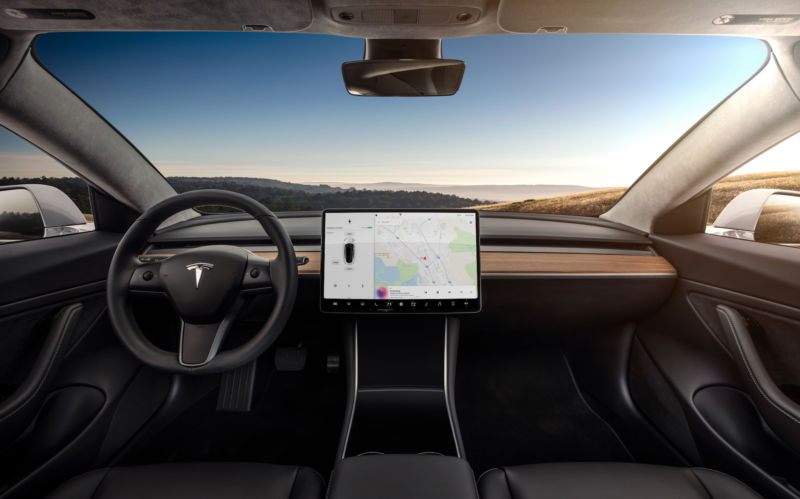May 31, 2018 at 01:51PM
via Ars Technica

Tesla pushed out a software update to Model 3s that dramatically improved the car's braking performance in certain conditions. The update came days after Consumer Reports announced that it could not recommend the vehicle based on inconsistent—and sometimes quite poor—braking performance.
The update shows the power of Tesla's over-the-air software update capabilities. But it also raises questions about how much testing Tesla did to its braking systems before launching the Model 3 in the first place.
Tesla quickly fixed the braking problem Consumer Reports identified
Consumer Reports purchased a Model 3 vehicle and is putting the vehicle through the same comprehensive battery of tests it applies to every new car model. One of those tests involves repeated testing of emergency stopping capabilities. Testers will speed the vehicle up to 60 miles per hour, then slam on the brakes to simulate an emergency braking situation. They drive the car around for a while to let the brakes cool off, then do the test again.
Testers expect the results to be consistent from one test to the next. But that's not what they found with the Tesla. The first braking test produced a respectable stopping distance around 130 feet (40 meters). But when they repeated the same test a few minutes later, the car took more than 150 feet (45 meters) to stop.
That's a problem, Consumer Reports said, because a typical luxury sedan stops in around 133 feet (41 meters). By contrast, the 152-foot average stopping distance CR measured for the Model 3 put it on par with a Ford F-150 pickup truck.
These results came out early last week, and they got the attention of Elon Musk, who talked to Jake Fisher, the director of the Consumer Reports car-testing program, by phone. Musk got details of how CR's test worked, then put his engineers to work on possible fixes. Within days, Musk announced that "This can be fixed with a firmware update. Will be rolling that out in a few days."
He described it as a problem with the "ABS [anti-lock braking system] calibration algorithm."
In the past, patching a car's braking firmware would have been a massive undertaking requiring cars to physically visit dealerships. But thanks to Telsa's over-the-air update capabilities, the company was able to push the new braking software out to all Tesla vehicles wirelessly in a matter of days.
"I've never seen a car that could improve its track performance with an over-the-air update," Fisher said.
“Something fundamentally broken in what they were doing”
Tesla has been vague about exactly what was wrong with the Model 3 brakes and how the patched software fixed them. But a good source here is Sam Abuelsamid, a former automotive engineer who is now an industry analyst at Navigant and a Forbes contributor.
"As a product development engineer, I spent 17 years working on electronic slip control systems including ABS, traction, and stability control," he writes.
It might seem like the brake pedal on your car directly controls the braking force, but the reality is more complicated than that, Abuelsamid explains. Modern brakes come with brake-assist capabilities that are "designed to detect a panic braking action by the driver and maximize braking force in order to help avoid a crash."
Often, drivers will initially apply the brake hard and then back off, leading to longer stopping distances. However, in calibrating this system, it's important not to have false positives of such brake applies, because [they] can lead to more braking force than the driver intended, sometimes causing them to be rear ended or at least have jerky braking performance.
According to Abuelsamid, conventional car companies spend months carefully calibrating these systems, testing them on a wide variety of surfaces and weather conditions.
"This process often entailed compromises that might trade off one surface a bit to gain some stopping distance or stability on another," he writes. "As we approached a production freeze, we would be battling to cut an extra foot of stopping distance, not 20 feet."
So the fact that Tesla's engineers were able to slash 20 feet (six meters) off of the Model 3's stopping distance after a few days of work suggests that the company had not subjected the brakes to particularly rigorous testing in the months before the Model 3's release.
And that raises questions about whether the brakes might perform poorly in other, more demanding situations, Abuelsamid says.
Dry pavement is one of the most forgiving braking surfaces. Are Tesla's brakes calibrated to give good performance on challenging situations like wet or icy roads? It's an important question—and we don't know how much testing Tesla has done to answer it.
"The fact that Tesla engineers were able to slash nearly 20 feet of stopping distance in a couple of days is a sign that there was something fundamentally broken in what they were doing," Abuelsamid concludes. "Given the speed of this update, it's likely that Tesla hasn't even evaluated those other surfaces yet and this may not be the last braking-related update for the Model 3."
Conventional car companies tend to be bureaucratic and methodical—they have a highly regimented process for designing, testing, and manufacturing their cars. Tesla has a different culture inherited from its Silicon Valley roots. The company relies on iteration and rapid feedback to improve its products over time.
The braking situation highlights both the strengths and weaknesses of that approach. Tesla's nimble culture allowed it to quickly solve a problem that cropped up after its car had left the factory. But perhaps the more bureaucratic approach of conventional car companies would have allowed the company to catch this kind of error before the Model 3 went on sale.
We've asked Tesla for comment and will update if it responds.